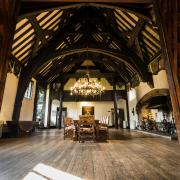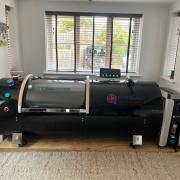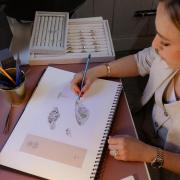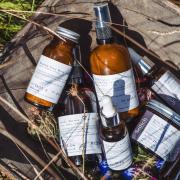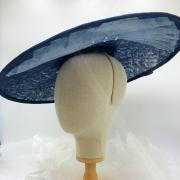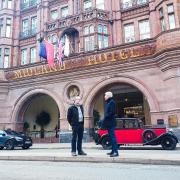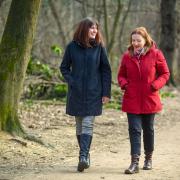For centuries, mankind has fought to harness the power of nature and bring her stunning potential under its will. At Heron Corn Mill, Stuart Hobbs’ careful and considered working and weaving among antique beams and machines has won over the River Bela at Beetham, producing flour for local consumers and creating a socially-engaged charity which allows visitors to see the timeless magic of milling in real-time.
The current millwright at the 18th century Grade II listed water mill, Stuart has been working on its maintenance and operation since 2006. Adding his input at first as a volunteer, over the last 18 years he has graduated to be its millwright and operator, turning a background in making and engineering into a role which keeps the mill wheels turning.
A decade ago, Heron Mill received almost £1 million in Heritage Lottery cash, which has allowed it to grow as an attraction as well as a commercial enterprise. As the mill dates back to 1740 – with previous upgrades in 1850 – there were idiosyncrasies specific to Heron Mill which Stuart learned from scratch.

In a time-honoured tradition, at Heron Mill the machinery uses a lot of wood and metal.
‘It was built to last, and the buildings – including the machinery – did take a lot of wear and tear. There are a lot of vibrations going off, and you’re exposed to elements as well with the river.’
The river is the always heard, often seen component without which the mill would stand dormant. Stuart says the team is lucky as the water level on the Bela at Beetham is always high enough to run the mill.

There are also man-made objects, he adds, such as car parts, bumpers and wheels, and even sheds. Throughout the work, respect for the river is paramount, Stuart explains.
‘You can plan work on mills around the water and it can be completely scuppered by the rain or the river flow. There are sometimes flood conditions and also, with a lot of wood used throughout the mill, it changes depending on the state of the weather or the season. It expands and contracts, and you’ve got to be aware of these things and the materials and how they react.’

‘When I started at the mill, it was just a turning museum so it showed you things going round by waterpower. But we’ve developed so now we have a hydroelectric turbine that generates electricity on site. So we’re using the river Bela which is a more modern aspect, you could say. It’s brilliant to be part of such an achievement, especially when nature is behind it all.’
The Heritage Lottery Funding came as Stuart was working as the millwright. The cash – a £939,100 grant in total – was used by a team of conservationists to make vital repairs to the mill building and improve its facilities and overall visitor experience.

Community groups and local history societies, as well as groups from schools studying forces and gears and hydro-electric power are regular visitors to the mill, which had an impact on the work being done.
‘The site had to be upgraded with consideration for public access, so we had to improve the paths and fencing around the site as well. We did that and worked on the working parts of the mill as well. It’s a constant, looking after the working parts of the mill.’

Stuart adds: ‘Heron Mill hadn’t really produced anything for sale since 1958, mainly flour products to start with but also animal feed. It wasn’t until 2014 after the building was renovated that we turned our attention to improving and maintaining the machinery more closely inside the mill. From there, we were able to start producing wholemeal flour for sale to the public.’
Since taking on the role of millwright, every creak and clunk the millstones make is almost part of Stuart himself.
‘At Heron Mill, there are no buttons to press, there’s no computer screens or digital screens to read. Everything is milled and adjusted using our senses.

‘Each variety of grain is different, which you only get through learning a mill or learning the feelings and the vibrations that come out of it.’
Stuart credits food trends with an uptick in the sale of milled products, as bakers are keen to try different flours.
‘This year we’ve had an increased interest in new flour and we also try to introduce new products with the type of flour used and new types of grain that are grown in the UK, so there are hundreds of varieties of wheat grain. We produce rye grain, spelt and something called blacksmith wheat which is very popular. We’ve also just started to make rolled oats for sale as well.’

He explains: ‘We put the grain into the mill stones and make adjustments then get the whole flour coming straight out – it can travel about five or six feet through the process from grain to flour and that’s ready to use.
‘In a modern mill it can travel probably over a quarter of a mile through different rollers and sieves and cleaners and then being milled again. It’s not that the modern process isn’t quick and efficient, but it produces heat in the flour that can start to change the make-up of the grain.’
Learning opportunities are rife at the mill for visitors and groups, with guided walks and talks, craft workshops and resources for schools to help people interact with and better understand the history of the mill and why it’s so important to the local community.

‘Now, it’s developed more so we do a lot more charitable work. We host everyone from children up to the elderly or people with neurological issues. We’ve also hosted migrants, and do projects with them.
‘The common factor that joins us all is our need and love for food. Here we can show them some of the skills and recipes we know and they can also show us some of their traditional recipes and baking skills, so it’s almost like a skill share. It opens a conversation and gets people interacting from a lot of different backgrounds.’
As a Living Heritage site, the mill hosts regular event days for staff, volunteers and the surrounding community to get involved with low-level maintenance, including giving the mill, barn and garden area a good clean and tidy.
The Bread of Heron community breadmaking group is also based at Heron Mill, where bakers “make it, bake it and eat it”, learning basic skills and having a chat. Stuart says he’s too busy to be involved in the baking too often, but adds that it’s a fun activity.
‘I don’t have time to bake a lot – but we definitely try the different products. It’s not just bread, we try mixing the flours and trying other types of baking so there are pastries, Yorkshire puddings, scones, fruit loaves and fruit cakes. It can be very versatile if you’re willing to give it a go.’
heronmill.org








